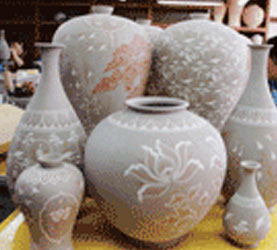Drying
After patterning, moisture within the celadon should be dried perfectly in order to enhance solidity and prevent damage. If there are moisture left, the work can crack due to expansion and rapid evaporation during other processes.
However, if the drying speed is too fast, the outer surface dries up first, blocking the air holes. Then the moisture inside could not escape. Thus the drying will take more time, and also be more prone to damage. And a perfectly dried celadon is very firm, letting kiln firing. But leftover moisture will undermine the capability to withstand the weight. A good way to dry Celadon is to provide a well-ventilated room, and an even drying speed of inner-outer and upper-lower surfaces.

Therefore the bigger the product is, it is more important to well ventilate or flip in order for the bottom to dry up. If it is a plate you should flip often, and if there are plenty of adhesive sites such as handles a cover (usually newspaper or vinyl) should be used, and celadon with lids should dried together as one. If the room temperature is too high or too windy, celadon should also be covered with paper or vinyl to control the speed of drying. If the room is too dry, spray some water at the room or on the surface. Especially in winter, temperature fluctuates greatly. So cover the celadon with paper and vinyl after forming in order to withstand the temperature change and dry up slowly.
In summer, Celadon should not be exposed to the sun since it causes immediate cracking and make shades with papers to avoid the high temperature. On the other hand, during rainy season, the high humidity could cause slow drying or damage of shape. Make fire within the room to adjust humidity.

